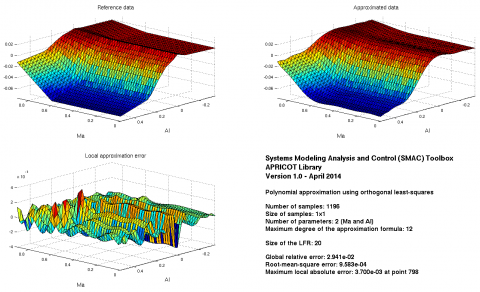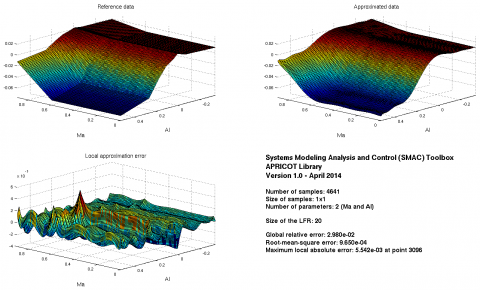Polynomial approximation of tabulated data using orthogonal least-squares.
Description
This routine uses Orthogonal Least-Squares to compute a multivariate polynomial approximation $f:\mathbb{R}^n\rightarrow\mathbb{R}^{n_1\times n_2}$ of a set of samples $\left\{y_k\in\mathbb{R}^{n_1\times n_2}, k\in [1, N]\right\}$ obtained for different values $\left\{x_k\in\mathbb{R}^n,k \in [1, N]\right\}$ of some explanatory variables $x\in\mathbb{R}^n$. The maximum degree of the polynomial function and the maximum admissible approximation error are set by the user. A sparse polynomial expression is usually obtained, which ensures that the global relative error or the root-mean-square error between $\left\{f(x_k), k\in [1, N]\right\}$ and $\left\{y_k, k\in [1, N]\right\}$ remains below the given threshold for each entry (see errapprox for precise definitions).
Syntax
[fdata,fdesc,fsym,flfr]=olsapprox(X,Y,names,maxerr{,options})
Input arguments
The first five input arguments are mandatory:
X | Values $\left\{x_k\in\mathbb{R}^n,k \in [1, N]\right\}$ of the explanatory variables $x$ ($n\times N$ array, where X(:,k) corresponds to $x_k$). |
Y | Samples $\left\{y_k\in\mathbb{R}^{n_1\times n_2}, k\in [1, N]\right\}$ to be approximated ($n_1\times n_2\times N$ array where Y(:,:,k) corresponds to $y_k$ in the general case, or possibly $1\times N$ array where Y(k) corresponds to $y_k$ if $n_1=n_2=1$). |
names | Names of the explanatory variables $x$ ($1\times n$ cell array of strings). |
maxdeg | Maximum degree of the approximating polynomial function $f$. |
maxerr | Maximum admissible approximation error (if possible):
|
The sixth input argument options is an optional structured variable with fields:
maxexp | Maximum exponent of each explanatory variable in the approximating polynomial function $f$ ($1\times n$ array). The default value is options.maxexp=maxdeg*ones(1,n). |
abserr | Maximum admissible local absolute error abs(Y(i1,i2,k)-fdata(i1,i2,k)) over all samples $k\in [1,N]$ and all entries $i_1\in [1,n_1]$ and $i_2\in [1,n_2]$ (if possible). The default value is options.abserr=Inf. |
pendeg | Penalization of each monomial proportionally to its degree (0 = no penalty, 1 = medium penalty, >1 = large penalty). The default value is options.pendeg=1. |
trace | Trace of execution (0=no, 1=text, 2=text+figures). The default value is options.trace=1. |
viewpoint | This option is applicable only if 3-D graphs are to be displayed (options.trace=2 and $n=2$). It represents the deviation with respect to the default viewpoint (see plotapprox). The default value is options.viewpoint=[0 0]. |
warn | Warnings display (0=no, 1=yes). The default value is options.warn=1. |
Output arguments
fdata | Values $\left\{f(x_k)\in\mathbb{R}^{n_1\times n_2},k \in [1, N]\right\}$ of the approximating function $f$ (same size as Y). |
fdesc | Description of the approximating function $f$ (fdesc{i1,i2}.coef(j) and fdesc{i1,i2}.exp(j,:) contain the coefficient and the exponents of the $j\,$th monomial used to approximate entry $(i_1\times i_2)$ of Y). |
fsym | Symbolic representation of the approximating function $f$ (symbolic object). |
flfr | Linear fractional representation of the approximating function $f$ (GSS object if the GSS library is installed, LFR object otherwise if the LFR toolbox is installed). |
Note
Il is possible to define a structure for the appoximating polynomial function. Assume for example that an expression of the form $f(x)=x(1)x(3)^2g(x(1),x(2))+x(2)^3h(x(1),x(4))$ is searched, which depends on 4 explanatory variables $x(1),\dots,x(4)$ and is composed of two polynomials $g$ and $h$. Three additional fields are introduced in the input variable options as follows:
options.parin={[1 2] [1 4]}options.parout={[1 3] [2]}options.expout={[1 2] [3]}
By default, no structure is considered, so options.parin={1:n},options.parout={[]} and options.expout={[]}.
Caution
If some values in X are much larger than 1, they must be scaled or normalized.
Example
Drag coefficient of a generic fighter aircraft model:load data_cx
Approximation on a rough grid:maxdeg=12;maxerr=-0.000959;options.trace=2; options.viewpoint=[-100 0];[fdata,fdesc,fsym,flfr]=olsapprox(X1,Y1,names,maxdeg,maxerr,options);
Validation on a fine grid:
plotapprox(Xv,Yv,names,flfr,options);See also
lsapproxqpapproxtrackerkoalaerrapproxplotapprox
References
| [1] | C. Poussot-Vassal and C. Roos, "Generation of a reduced-order LPV/LFT model from a set of large-scale MIMO LTI flexible aircraft models", Control Engineering Practice, vol. 20, no. 9, pp.919-930, 2012. |
| [2] | C. Roos, "Generation of LFRs for a flexible aircraft model", Optimization based clearance of flight control laws, Lecture Notes in Control and Information Sciences, vol. 416, pp. 59–77, Springer Verlag, 2011. |


